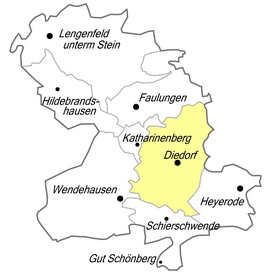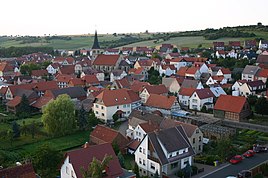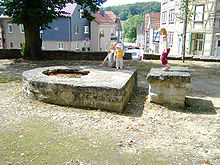Diedorf (Südeichsfeld)
|
Diedorf
Rural community of Südeichsfeld
|
|
|---|---|
| Coordinates: 51 ° 10 ′ 35 ″ N , 10 ° 16 ′ 56 ″ E | |
| Height : | 366 m |
| Incorporation : | April 21, 1995 |
| Incorporated into: | Katharinenberg |
| Postal code : | 99988 |
| Area code : | 036024 |
|
Location of Diedorf in Südeichsfeld
|
|
|
Bird's eye view of the place
|
|
Diedorf is a village in the Upper Eichsfeld and at the same time a district of the rural community Südeichsfeld in the Unstrut-Hainich district in Thuringia . It has about 1500 inhabitants.
geography
Diedorf is located in the Eichsfeld-Hainich-Werratal nature park , in the upper part of the Haselbachtal and is framed by the mountainous landscape of the western upper field . This is where the Thuringian-Hessian Heldrabach rises , called Haselbach in Thuringia . South of the village with the center at about 385 m above sea level. NN , a mountain range stretches from the Dörnerberg ( 478.1 m above sea level ) over the Dünkebiel ( 439.1 m above sea level ) to the Semmberg (east summit 465.1 m above sea level ; with a sinkhole ), the one represents the natural border to the southeastern neighboring village of Heyerode . The north-western neighboring village is Katharinenberg . To the southwest lies the village of Wendehausen on the middle reaches of the Haselbach .
history
The first documentary mention of the place took place in the Codex Eberhardi , an illustrated parchment codex written by monk Eberhard in the Fulda monastery in the middle of the 12th century, in which old donation and privilege certificates were copied. Diedorf's entry in Codex Eberhardi is during the term of office of Abbot Ratger, the third abbot of Fulda between 802 and 817. The first mention, presumed until 2010, is based on a document from 897 when a nobleman Wicer with his wife Heilica owned property at the monastery Fulda transferred, whereby a place Dietdorfen was also mentioned. With the lead name Wigger , a representative of the later count family Wigger appears here - at times even burgraves of the Wartburg .
As the center of the place, the St. Alban's Church also points to a great age. The church patronage of St. Alban refers to the St. Albans Abbey in Mainz and thus to the 9th century. Similar to the surrounding villages, for example Langula , Mihla and Flarchheim , a noble family of Diedorf emerged in Diedorf in the Middle Ages , which named itself after the place. It is mentioned a few times between the 13th and 14th centuries, at a time when the family had long since ceased to live in Diedorf. A representative of this noble clan was Raboto von Diedorf , who first appeared as a witness in 1250 in a document from the knight Werner Schieferstein, called von Mühlhausen, when he founded the monastery in Breitenbich and equipped it with 22 Hufen land. Another document from the year 1253 testifies that Raboto married into a Mühlhausen patrician family. On February 16, 1334, a brother Heinrich von Diedorf, a priest, witnessed when Ysentrud von Eigenrieden, together with her daughter Katharina , bought and donated interest from a hoof to the Teutonic Order in Mühlhausen. Heinrich names all other witnesses "brothers" in the document, which suggests that he was a member of the Teutonic Order. There is no further evidence for the von Diedorf family; it may have died out in the Middle Ages.
An eye-catcher in the middle of the village is the elevated meadow with its old linden trees . This still served as a meeting and execution place in the 19th century .
According to a statistical study, the village had 878 Catholic and 6 Protestant inhabitants around 1840. In the village, the most important building after the church was the manor of the Chamberlain von Harstall. 127 houses, 135 stables and barns, a school and a village pitcher were also mentioned. Only one teacher could be employed, he taught the 84 boys and 68 girls of compulsory schooling. The population still lived in oppressive poverty. At that time, Diedorf was mainly engaged in craft weaving and textile manufacturing, mostly as a sideline. The overview lists three tailors, three shoemakers, two wheelwrighters, two blacksmiths, a baker, two butchers, a carter, four fur traders, a wholesaler and five grocers as trades and craft businesses. The estate included five servants and 13 maids as well as one maid. The total livestock included 43 horses, 119 cattle, 438 sheep, 37 goats and 51 pigs. The village corridor comprised 3,303 acres , of which the arable land comprised 1650 acres of arable land, 22 acres of garden land, 70 acres of meadows and 62 acres of pasture. In addition, 666 acres of community forest and 833 acres of fallow land were named. The yield of the fields was assessed as poor to mediocre.
In 1897 the first stocking and waistcoat knitting factory was founded in Diedorf. Diedorf was considered the center of stocking manufacture, and a stocking museum has now been set up in the village. In the same year the Church of St. Albanus was built.
Diedorf had a stop on the Vogteier Bimmelbahn , which was a railway line that connected the place with the neighboring cities of Mühlhausen , Treffurt and Wanfried . The line started operating in 1911. From 1952, the Treffurt station was no longer served. In passenger traffic, the line was in operation until September 29, 1968 to Wendehausen. The section Treffurt-Heyerode has meanwhile been redesigned as a railway cycle path , the route is part of the Unstrut-Werra cycle path.
During the fierce fighting in April 1945, Diedorf was not far from the combat zone, the center of which was in the area around the village of Struth . The Diedorf population was therefore in dire need and concern for life and limb and sought protection in the forests.
The place was located in the border area of the GDR until autumn 1972 and could only be entered and left with special permission. Up until 1989 there were guard houses and barriers on the town signs in the direction of Wendehausen and Katharinenberg, which were manned by armed guards from the GDR border troops. A pass had to be applied for to enter the border area. This pass was issued to the extent that the applicant does not regularly visit the border area, e.g. B. for reasons of a permanent job or residence, is not infrequently limited to just two hours.
In the north of Diedorf, on a hill in the Mühlhausen city forest , there was a Red Army military base with a radio tower. Café Moscow , as the tower was jokingly referred to by the residents of the surrounding villages, was a well-known landmark in northern Hainich . In 1995 the tower was dismantled.
In 1991 Diedorf was the first district winner in the competition Our village should become more beautiful. The agricultural cooperative Diedorf Eichsfeld eG is one of the most important local employers today
On April 21, 1995 Diedorf was incorporated into the new Katharinenberg community. With its dissolution, the place came to the municipality of Südeichsfeld on December 1, 2011.
In 2017 Diedorf celebrates the 1200th anniversary of its first documentary mention.
politics
Local council
The local council consists of eight people.
Local mayor
Mr. Andreas Henning was elected mayor .
Culture and sights

In the 1500-strong village of Diedorf there is a community and a parish library, the stocking museum and ten registered associations. The oldest is the choral society Cäcilia 1888 eV
Diedorf fair and carnival
The annual traditional festivals are very well maintained. The most important is the Kirchweihfest (big fair ), which is celebrated every year on the last weekend in September. In the Eichsfeld region, the parish fair is of great importance in traditional village life. Part of the fair is the traditional shaving of the fair boys' firstlings ("Gallinger") on the village green. Thereafter, these are considered to have been included in the fair society. The Butzemänner are also unique, they are fun fair boys in their 2nd and 3rd year who dress up and playfully chase after children with whips and shoe polish in order to beautify their faces with color. The carnival is celebrated in a big way by the Diedorfer Carneval Association, founded in 1956, with ceremonial meetings, women's, children's and senior carnival and a large carnival parade with subsequent handover of the town hall keys to the fools' guild on the Anger.
Village green
The village green is located in the center of the village at a crossroads. It is bordered by stone slabs lined up vertically and was the village's meeting place. On the west side of the Angers you can see two stone crosses. The Anger is said to have been used as a meeting place, market, and courtroom since the 9th century.
The holy grave
The Holy Sepulcher , a late Gothic sculpture carved from a stone, is of great art historical value and was installed in the St. Albanus Church , built in 1897 east of Angers . The masterful work, presumably from an Erfurt workshop, is the depiction of the rest bed of Jesus Christ. It is Jesus surrounded by his disciples and his mother Maria .
The prehistory of this work of art is remarkable. The holy grave is said to have originally been intended for a pilgrimage church near Eisenach , but because of the violent anti-clerical revolt known as the Pfaffensturm , it never made it. The von Harstall family , who belonged to the landed gentry in Diedorf and Mihla and were already very wealthy at that time, had already secretly taken possession of the picture and had it buried in a safe hiding place in Hainich , where it had been hidden for over 50 years and so in was forgotten by the population. In the meantime, the Peasants' War had also hit the Eichsfeld and prevented the completion of the pilgrimage church of Katharinenberg, which was then built with the support of the Diedorfer Harstalls. It was not until the late 16th century that the Diedorf Harstalls dared to show the work in public again. However, since the Katharinenberg chapel was never completed, it was left to be installed in the Diedorf church. The following legend about the miraculous discovery was even circulated in order to justify a pilgrimage of its own.
By chance, a hunter once discovered the sculpture in Hainich and had it excavated. The holy grave was loaded onto an ox cart and should be taken to Katharinenberg. Halfway between Diedorf and Katharinenberg, however, the oxen got tired and night fell. So they left the grave on the wagon in the direction of Katharinenberg and went home. The next morning the car was still in the same place, but in the direction of Diedorf. Since one could not imagine how the heavy wagon could have moved by itself, this was taken as a heavenly sign and the grave was not brought to the destroyed church in Katharinenberg, but to the church of Diedorf. It is still there today, almost intact.
Stocking museum
Around the turn of the 20th century, up to 13 smaller companies were founded in the village, which supplied the textile market as knitting companies. The Diedorf hosiery factory later emerged from the many small companies . In the multi-purpose building of the municipal administration you can visit the "Diedorf stocking museum". The tour enables a comprehensive insight into the manufacturing techniques and working conditions of the Diedorf knitting mills. If you also take home work into account, the local trade has a centuries-old tradition.
Sons and daughters of the church
- 1830, June 5, John Motz , editor of the Berliner Journal and local politician in Kitchener, Waterloo Region, Ontario, Canada
Others
As evidence of coarse folk humor, neck names and nicknames that characterize each village developed centuries ago . Accordingly, the Diederfer Spetter - Diedörfer Spötter, also Gelgenschißer - Gelgen = small wooden tubs, feed troughs lived here in the village .
literature
- Festschrift 1100 Years of Diedorf 897–1997. 100 years of the Church of Saint Albanus 1897–1997 . Municipality of Diedorf, Diedorf 1997.
- Ernst Mehler: Chronicle of Diedorf in the Eichsfeld. According to archival, literary and other sources (= Eichsfelder Land-Bücherei . Volume 8 ). FW Cordier, 1925, ZDB -ID 31780-9 .
- Raymund Falk: The desert of Reichensachsen near Heyerode and the settlement of the Hainich low mountain range . In: Eichsfeld. Yearbook . tape 1 , 1993, ISSN 1610-6733 , pp. 127-160 .
- Alfons Monday: Diedorf in Eichsfeld. Story in pictures . Mecke Druck und Verlag, Duderstadt 1999, ISBN 3-932752-45-7 .
- Raymund Falk: Diedorf in the Middle Ages. In: Eichsfeld-Jahrbuch, ISSN 1610-6741 , Vol. 5 (1997), pp. 75-120
- Ulrich Hussong: The first mention of Dingelstädt, Kreuzebra and Diedorf in the year 817. In: Eichsfeld-Jahrbuch 18 (2010), pp. 13-26
Web links
- Diedorf overview. Retrieved December 4, 2018 .
Individual evidence
- ↑ Raymund Falk: The deserted Reichensachsen near Heyerode and the settlement of the Hainich low mountain range. In: Eichsfeld. Yearbook. Vol. 1, 1993, pp. 127-160, here pp. 131-134, 140.
- ^ Raymund Falk: Diedorf in the Middle Ages. In: Eichsfeld. Yearbook. Vol. 5, 1997, pp. 75-120, here p. 94.
- ^ Edgar Rademacher: The places Arenshausen, Geismar, Katharinenberg, Diedorf and Heyerode in the mirror of statistics around 1840. In: Eichsfelder Heimathefte. Vol. 28, No. 2, 1988, ISSN 0232-8518 , p. 176.
- ↑ Wolfgang Trappe: 50 years ago in April. War in Eichsfeld . In: The Eichsfeld. Monthly magazine of the Eichsfeldes . tape 39 , 1995, ZDB -ID 913387-2 , p. 89-96 .
- ↑ Harald Rockstuhl: Soviet radar station at Eigenrieden im Hainich in Thuringia 1983–1995 . Rockstuhl, Bad Langensalza 2006, ISBN 3-937135-79-0 .
- ↑ StBA: Changes in the municipalities of Germany, see 1995
- ↑ 1200 years Diedorf website ( Memento of the original from January 31, 2017 in the Internet Archive ) Info: The archive link has been inserted automatically and has not yet been checked. Please check the original and archive link according to the instructions and then remove this notice.
- ↑ Responsibilities / contact persons. Retrieved December 4, 2018 .
- ↑ Rarely in Central Germany. Holy grave in Diedorf is 500 years old. In: Day of the Lord . Edition Erfurt, online edition. Retrieved December 9, 2016 .
- ^ NN: Hosiery Museum in Diedorf . In: hainichlandaktiv . June 2007, p. 3-4 .
- ↑ Rolf Aulepp: Nicknames of the places and their residents in the Mühlhausen district. In: Eichsfelder Heimathefte. Vol. 27, No. 1, 1987, pp. 78-83.






